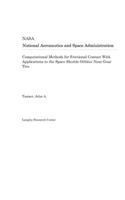
Computational Methods for Frictional Contact with Applications to the Space Shuttle Orbiter Nose-Gear Tire
Series:
A computational procedure is presented for the solution of frictional contact problems for aircraft tires. A Space Shuttle nose-gear tire is modeled using a two-dimensional laminated anisotropic shell theory which includes the effects of variations in material and geometric parameters, transverse-shear deformation, and geometric nonlinearities. Contact conditions are incorporated into the formulat
NaN
VOLUME
English
Paperback

A computational procedure is presented for the solution of frictional contact problems for aircraft tires. A Space Shuttle nose-gear tire is modeled using a two-dimensional laminated anisotropic shell theory which includes the effects of variations in material and geometric parameters, transverse-shear deformation, and geometric nonlinearities. Contact conditions are incorporated into the formulation by using a perturbed Lagrangian approach with the fundamental unknowns consisting of the stress resultants, the generalized displacements, and the Lagrange multipliers associated with both contact and friction conditions. The contact-friction algorithm is based on a modified Coulomb friction law. A modified two-field, mixed-variational principle is used to obtain elemental arrays. This modification consists of augmenting the functional of that principle by two terms: the Lagrange multiplier vector associated with normal and tangential node contact-load intensities and a regularization term that is quadratic in the Lagrange multiplier vector. These capabilities and computational features are incorporated into an in-house computer code. Experimental measurements were taken to define the response of the Space Shuttle nose-gear tire to inflation-pressure loads and to inflation-pressure loads combined with normal static loads against a rigid flat plate. These experimental results describe the meridional growth of the tire cross section caused by inflation loading, the static load-deflection characteristics of the tire, the geometry of the tire footprint under static loading conditions, and the normal and tangential load-intensity distributions in the tire footprint for the various static vertical loading conditions. Numerical results were obtained for the Space Shuttle nose-gear tire subjected to inflation pressure loads and combined inflation pressure and contact loads against a rigid flat plate. The experimental measurements and the numerical results are compared. Tanner, ...
Price Comparison [India]
In This Series
Bestseller Manga
Trending NEWS




















